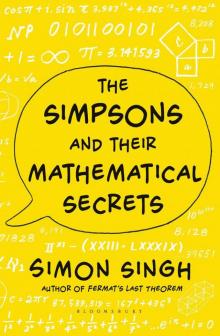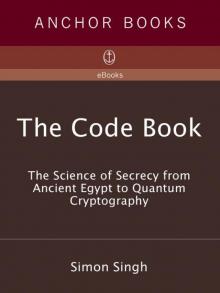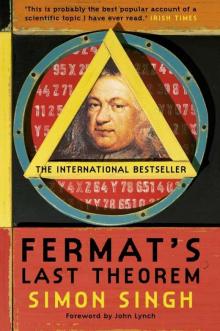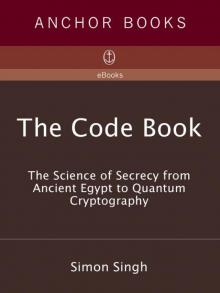- Home
- Simon Singh
The Simpsons and Their Mathematical Secrets Page 2
The Simpsons and Their Mathematical Secrets Read online
Page 2
The first nerd was Mike Reiss, whom I met when I spent a few days with the writers of The Simpsons. Just like Maggie, he displayed his mathematical talents while playing with building blocks as a toddler. He distinctly recalls a moment when he observed that the blocks obeyed a binary law, inasmuch as two of the smallest blocks were the same size as one medium block, while two of the medium blocks were the same size as one large block, and two of the large blocks equaled one very large block.
As soon as he could read, Reiss’s mathematical interest matured into a love of puzzles. In particular, he was captivated by the books of Martin Gardner, the twentieth century’s greatest recreational mathematician. Gardner’s playful approach to puzzles appealed to both young and old, or as one of his friends once put it: “Martin Gardner has turned thousands of children into mathematicians, and thousands of mathematicians into children.”
Reiss began with The Unexpected Hanging and Other Mathematical Diversions and then spent all his pocket money on other puzzle books by Gardner. At the age of eight, he wrote to Gardner explaining that he was a fan and pointing out a neat observation concerning palindromic square numbers, namely that they tend to have an odd number of digits. Palindromic square numbers are simply square numbers that are the same when written back to front, such as 121 (112) or 5,221,225 (2,2852). The eight-year-old was absolutely correct, because there are thirty-five such numbers less than 100 billion, and only one of them—698,896 (8362)—has an even number of digits.
Reiss reluctantly admitted to me that his letter to Gardner also contained a question. He asked if there was a finite or infinite supply of prime numbers. He now looks back on the question with some embarrassment: “I can visualize the letter so perfectly, and that’s a real stupid, naïve question.”
Most people would consider that Reiss is being rather harsh on his eight-year-old self, because the answer is not at all obvious. The question is based on the fact that each whole number has divisors, which are those numbers that will divide into it without any remainder. A prime number is notable because it has no divisors other than 1 and the number itself (so-called trivial divisors). Thus, 13 is a prime number because it has no non-trivial divisors, but 14 is not, because it can be divided by 2 and 7. All numbers are either prime (e.g., 101) or can be broken down into prime divisors (e.g., 102 = 2 × 3 × 17). Between 0 and 100 there are 25 prime numbers, but between 100 and 200 there are only 21 primes, and between 200 and 300 there are only 16 primes, so they certainly seem to become rarer. However, do we eventually run out of primes, or is the list of primes endless?
Gardner was happy to point Reiss toward a proof by the ancient Greek scholar Euclid.3 Working in Alexandria around 300 B.C., Euclid was the first mathematician to prove that there existed an infinity of primes. Perversely, he achieved this result by assuming the exact opposite and employing a technique known as proof by contradiction or reductio ad absurdum. One way to interpret Euclid’s approach to the problem is to begin with the following bold assertion:
Assume that the number of primes is finite and all these primes have been compiled into a list:
p1, p2, p3, …, pn.
We can explore the consequences of this statement by multiplying all the primes on the list and then adding 1, which creates a new number: N = p1 × p2 × p3 × … × pn + 1. This new number N is either a prime number or not a prime number, but either way it contradicts Euclid’s initial assertion:
(a) If N is a prime number, then it is missing from the original list. Therefore, the claim to have a complete list is clearly false.
(b) If N is not a prime number, then it must have prime divisors. These divisors must be new primes, because the primes on the original list will leave a remainder of 1 when divided into N. Therefore, again, the claim to have a complete list is clearly false.
In short, Euclid’s original assertion is false—his finite list does not contain all the prime numbers. Moreover, any attempt to repair the claim by adding some new prime numbers to the list is doomed to failure, because the entire argument can be repeated to show that the enhanced list of primes is still incomplete. This argument proves that any list of prime numbers is incomplete, which implies that there must be an infinity of primes.
As the years passed, Reiss developed into a very accomplished young mathematician and earned a place on the state of Connecticut mathematics team. At the same time, he was developing a flair for comedy writing and was even receiving some recognition for his talent. For example, when his dentist boasted to him about how he always submitted witty, but unsuccessful, entries for New York magazine’s weekly humor competition, young Michael trumped him by announcing that he had also entered and been rewarded for his efforts. “I would win it a lot as a kid,” said Reiss. “I didn’t realize I was competing against professional comedy writers. I found out later all the Tonight Show writers would be entering the contest and here I was, aged ten, and I would win it, too.”
Mike Reiss (second in the back row) on the 1975 Bristol Eastern High School Mathematics Team. As well as Mr. Kozikowski, who coached the team and appears in the photograph, Reiss had many other mathematical mentors. For example, Reiss’s geometry teacher was Mr. Bergstromm. In an episode titled “Lisa’s Substitute” (1991), Reiss showed his gratitude by naming Lisa’s inspirational substitute teacher Mr. Bergstromm.
When Reiss was offered a place at Harvard University, he had to decide between majoring in mathematics or English. In the end, his desire to be a writer eclipsed his passion for numbers. Nevertheless, his mathematical mind always remained active and he never forgot his first love.
The other gifted mathematician who helped give birth to The Simpsons went through a similar set of childhood experiences. Al Jean was born in Detroit in 1961, a year after Mike Reiss. He shared Reiss’s love of Martin Gardner’s puzzles and was also a mathlete. In 1977, in a Michigan mathematics competition, he tied for third place out of twenty thousand students from across the state. He even attended hothousing summer camps at Lawrence Technological University and the University of Chicago. These camps had been established during the cold war in an effort to create mathematical minds that could rival those emerging from the Soviet network of elite mathematics training programs. As a result of this intense training, Jean was accepted to study mathematics at Harvard when he was only sixteen years old.
Once at Harvard, Jean was torn between his mathematical studies and a newly discovered interest in comedy writing. He was eventually accepted as a member of the Harvard Lampoon, the world’s longest-running humor magazine, which meant he spent less time thinking about mathematical proofs and more time thinking up jokes.
Reiss was also a writer for the Harvard Lampoon, which had become famous across America after it published Bored of the Rings in 1969, a parody of Tolkien’s classic. This was followed in the 1970s by a live theater show called Lemmings, and then a radio show titled The National Lampoon Radio Hour. Reiss and Jean forged a friendship and writing partnership at the Harvard Lampoon, and it was this college experience that gave them the confidence to start applying for jobs as TV comedy writers when they eventually graduated.
Their big break came when they were hired as writers on The Tonight Show, where their innate nerdiness was much appreciated. As well as being an amateur astronomer, host Johnny Carson was a part-time debunker of pseudoscience, who from time to time donated $100,000 to the James Randi Educational Foundation, an organization dedicated to rational thinking. Similarly, when Reiss and Jean left The Tonight Show and joined the writing team for It’s Garry Shandling’s Show, they discovered that Shandling himself had majored in electrical engineering at the University of Arizona before dropping out to pursue a career in comedy.
Then, when Reiss and Jean joined the writing team for the first season of The Simpsons, they felt that this was the ideal opportunity to express their love of mathematics. The Simpsons was not just an entirely new show, but also an entirely new format, namely a prime-time animated sitcom aimed at all ages.
The usual rules did not apply, which perhaps explains why Reiss and Jean were allowed—and indeed encouraged—to nerdify episodes whenever possible.
A photograph of the mathematics team from the 1977 Harrison High School yearbook. The caption identifies Al Jean as the third student in the back row and notes that he won gold and third place in the Michigan state competition. Jean’s most influential teacher was the late Professor Arnold Ross, who ran the University of Chicago Summer program.
In the first and second seasons of The Simpsons, Reiss and Jean were key members of the writing team, which enabled them to include several significant mathematical references. However, the mathematical heart of The Simpsons beat even stronger in the third season and beyond, because the two Harvard Lampoon graduates were promoted to the roles of executive producers.
This was a crucial turning point in the mathematical history of The Simpsons. From this point onward, not only could Jean and Reiss continue to parachute their own mathematical jokes into the episodes, but they could also begin to recruit other comedy writers with strong mathematical credentials. Over the coming years, The Simpsons script-editing sessions would occasionally take on an atmosphere reminiscent of a geometry tutorial or a seminar on number theory, and the resulting shows would contain more mathematical references than any other series in the history of television.
CHAPTER 2
Are you π-Curious?
Sometimes the mathematical references inserted in The Simpsons are highly obscure, and indeed we will encounter some of them in the next chapter. On other occasions, the jokes inserted by Reiss, Jean, and their colleagues incorporate mathematical concepts that will be familiar to many viewers. A classic example is the number π, which has made several guest appearances in the series over the past two decades.
Just in case you have forgotten, π is simply the ratio of the circumference of a circle to its diameter. Anyone can obtain a rough sense of π’s value by drawing a circle, and then cutting a piece of string so that it is as long as the circle’s diameter. That string will run around the edge of the circle a bit more than three times, or 3.14 times to be slightly more precise. That is the approximate value of π. This relationship between π and a circle’s circumference and diameter is summarized in the following equation:
circumference
=
π × diameter
C
=
πd
Since the diameter of a circle is double the length of the radius, the equation can also be expressed in the following way:
circumference
=
2 × π × radius
C
=
2πr
This is perhaps the first small step that we take as children from simple arithmetic to more complex ideas. I can still remember my own first encounter with π, because it left me flabbergasted. Mathematics was no longer just about long multiplication and vulgar fractions, but was now also about something esoteric, elegant, and universal; every circle in the world obeyed the π equation, from Ferris wheels to Frisbees, from chapatis to the Earth’s equator.
And, as well as predicting the circumference of a circle, π can also be used to calculate the area within the circumference:
Area
=
π × radius2
A
=
πr2
There is a pun-based joke referring to this particular equation in the episode “Simple Simpson” (2004). In this episode, Homer disguises himself as a superhero named Simple Simon, Your Friendly Neighborhood Pie Man, and punishes evildoers by flinging pies in their faces. The Pie Man’s first act of superheroism is to deliver retribution to someone who bullies Lisa. This is witnessed by a character named Drederick Tatum, Springfield’s famous ex-boxer, who proclaims: “We all know ‘πr2’, but today ‘pie are justice’. I welcome it.”
Although Al Jean introduced this joke into the script, he is reluctant to take all the credit (or perhaps all the blame): “Oh, that’s an old joke. That was definitely a joke I’d heard years ago. The guy who should get credit is somebody from 1820.”
Jean is exaggerating when he says 1820, but Tatum’s words do indeed offer a fresh twist on a traditional joke that has been handed down from one generation of mathematicians to the next. The most famous version of the joke appeared in 1951 on the American comedy series The George Burns and Gracie Allen Show. During an episode titled “Teenage Girl Spends the Weekend,” Gracie comes to the aid of young Emily, who is complaining about her homework:
EMILY:
I wish geometry were as easy as Spanish.
GRACIE:
Well maybe I can help you. Say something to me in geometry.
EMILY:
Say something in geometry?
GRACIE:
Yeah, go ahead.
EMILY:
Well, alright. Errr . . . πr 2.
GRACIE:
Is that what they teach you in school these days? πr 2?
EMILY:
Yeah.
GRACIE:
Emily. Pie are round. Cookies are round. Crackers are square.
These jokes rely on the fact that “pie” and “π” are homophones, which lends itself to punnery. Hence, comedians owe a debt of gratitude to William Jones, who was responsible for popularizing the symbol π. This eighteenth-century mathematician, along with many others, earned his living by offering tutorials in London’s coffee houses in exchange for a penny. While he was plying his trade at these so-called Penny Universities, Jones was also working on a major treatise titled A New Introduction to the Mathematics, and this was the first book to employ the Greek letter π in the context of discussing the geometry of circles. Thus the potential for new mathematical punning was born. Jones chose π because it is the initial letter of the Greek word περιφέρεια (periphereia), meaning circumference.
Three years before the appearance of the π gag in “Simple Simpson,” the writers of The Simpsons had included another reference to π in the episode “Bye, Bye, Nerdie” (2001). This time, instead of resurrecting an old joke, the writers created some genuinely new π humor, albeit based on a curious incident from π’s history. To appreciate this joke, it is first necessary to remind ourselves of the value of π and how it has been measured over the centuries.
I stated earlier that π = 3.14 is only an approximation. This is because π is known as an irrational number, which means that it is impossible to specify its value with perfect accuracy because its decimal places continue to infinity without any pattern. Nevertheless, the challenge for early mathematicians was to go beyond the rough and ready estimate of 3.14, and to pin down this elusive number by measuring it as accurately as possible.
The first serious attempt at a more precise measurement of π was made by Archimedes in the third century B.C. He could see that an accurate measurement of π depended on an accurate measurement of the circumference of a circle. This is inevitably tricky, because circles are built from sweeping curves, not straight lines. Archimedes’s great breakthrough was to sidestep the problem of measuring curves by approximating the shape of a circle with straight lines.
Consider a circle with diameter (d) equal to 1 unit. We know that C = πd, which means it has a circumference (C) equal to π. Next draw two squares, one around the outside of the circle and one tucked inside the circle.
The actual circumference of the circle must, of course, be smaller than the perimeter of the large square and larger than the perimeter of the small square. So, if we measure the perimeters of the squares, we can obtain upper and lower bounds on the circumference.
The perimeter of the large square is easy to measure, because each side is the same length as the circle’s diameter, which we know to be equal to 1 unit. Therefore the perimeter of the large square measures 4 × 1 units = 4 units.
The perimeter of the small square is a little trickier to fathom, but we can pin down the length of each side by using the Pythagorean theorem. Con
veniently, the diagonal of the square and two of its sides form a right-angled triangle. The hypotenuse (H) is not only equal in length to the diagonal of the squarte, but it is also as long as the circle’s diameter, namely 1 unit. The Pythagorean theorem states that the square of the hypotenuse is equal to the sum of the squares of the other two sides. If we label the sides of the square S, then this means that H2 = S2 + S2. If H = 1, then the other two sides must each have a length of 1/√2 units. Therefore the perimeter of the small square measures 4 × 1/√2 units = 2.83 units.
As the circumference of the circle must be less than the perimeter of the large square, yet greater than the perimeter of the small square, we can now declare with confidence that the circumference must be between 2.83 and 4.00.
Remember, we stated earlier that a circle with a diameter of 1 unit has a circumference equal to π, therefore the value of π must lie between 2.83 and 4.00.
This was Archimedes’s great discovery.
You might not be impressed, because we already know that π is roughly 3.14, so a lower bound of 2.83 and an upper bound of 4.00 are not very useful. However, the power of Archimedes’s breakthrough was that it could be refined. For, instead of trapping the circle between a small and a large square, he then trapped the circle between a small and a large hexagon. If you have ten minutes to spare and some confidence with numbers, then you can prove for yourself that measuring the perimeters of the two hexagons implies that π must be more than 3.00 and less than 3.464.

 The Simpsons and Their Mathematical Secrets
The Simpsons and Their Mathematical Secrets The Code Book
The Code Book Fermat's Last Theorem
Fermat's Last Theorem The Code Book: The Science of Secrecy from Ancient Egypt to Quantum Cryptography
The Code Book: The Science of Secrecy from Ancient Egypt to Quantum Cryptography